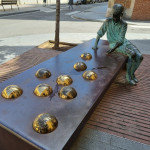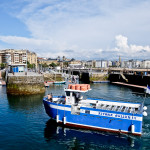Lynne Coates visits Almeria and follows in the footsteps of Indiana Jones through its desert landscapes.
We had a choice – take the stony track in front of us and risk a puncture on our hire car, miles from civilisation, or turn around and miss the iconic location we had just driven miles to see. We risked it, and my goodness it was worth it.
In the southeast corner of the Iberian Peninsula, just a couple of hours’ drive from the tourist hotspots of the Costa del Sol, the city and municipality of Almeria offer a very different experience.
The city has a ferry and cruise port, an intriguing old town, Alcazaba fortress, and an edgy character. Mostly, the region is known for film tourism. Its desert landscapes, vast mountain ranges and ruggedly beautiful coves, provide the film industry with spectacular backdrops, and have provided locations for some of the most iconic films ever made.

We stay in the centre of the old town at Catedral Almeria, a boutique hotel in the Plaza de Catedral, which provides the perfect location. From our room on the fifth floor, we have a birds-eye view of the Plaza and can almost touch the adjacent Cathedral from our terrace. Regarded as one of Spain’s national historic monuments, the Cathedral is unique, both as a place of worship and as a fortified refuge.
Dating back to the 16th century, the exterior walls are Gothic, whilst the interior architecture combines elements of Baroque, Neoclassical and Renaissance, styles. The tower bells chime every fifteen minutes, from 8am, but mercifully stop at midnight – just as well as we plan an early start!
From the Plaza the narrow streets are easy to navigate, and we set off in the direction of the famous Alcazaba fortress. En route we pass through Plaza Granero, a charming square with a replica of an old fountain. Apparently, the original was relocated to the airport when Franklin J. Shaffner was directing the film, Patton. He didn’t like the way it looked for the scene of Montgomery’s triumphal entry into the city of Messina (actually Almeria in the film).

In the same square the windows of the buildings are painted over with lifelike murals of local residents, created as part of a cultural project to revitalise the historic centre. In nearby Plaza Campoamor, we see a beautiful aluminium monolith on which the author Ramón de Campoamor, inscribed ‘If it is true, it is proper to love to sum up the whole world in one being’. Inspired by his words a low fence surrounding the monument is filled with padlocks placed by loving couples. In Plaza de las Flores, we find a statue of John Lennon who wrote ‘Strawberry Fields Forever’ while on holiday in Almeria.
The city’s Cinema House Museum has a recreation of the room he stayed in. Finally, we arrive at Almeria’s most famous landmark, the Alcazaba. This magnificent fortress, perched high on the hillside above the old town, dominates the horizon. After the Alhambra in Granada, this is Spain’s largest Muslim construction, its walled perimeter extending to some 1430 metres. Built by Abderrahman lll in the tenth century, it comprises three sites, two Muslim and one Christian.

Entrance to the fortress is free but be prepared for a steep climb through the ‘Torre de la Guardia’ main entrance. It’s obvious why such a dramatic setting attracted film makers, and it became the backdrop for films such as, Conan the Barbarian, Indiana Jones, Never Say Never Again, and, most recently, Wonder Woman and the TV series Queen of Swords.
Hungry after a day of sight-seeing we discover that restaurants in Almeria don’t open until eight o’clock, so we survive on coffee and cake. We are at the front of the queue in the street outside Casa Puga, which turns out to be one of the most popular Tapas restaurants in town, quickly filling up with locals (always a good sign). We enjoy a feast of seafood with a couple of glasses of Verdejo, and sleep soundly, despite the bells.
With an early start, we leave Almeria city, heading for Cabo de Gata Geopark, to see the famous Mónsul Cove, about an hour’s drive. On reaching the bay, the road runs out, and, to reach the cove, we must navigate a 4-kilometre stony track. Whilst 4×4’s wizz past, we proceed cautiously in our hire-car to avoid a puncture in this remote location.

As volcanic peaks, and glittering white sand come into view, we agree it was worth the risk. Known as Mónsul Duna Rampante, its Peineta (geological structures) and the Ola (two large rocky formations) are remains of coalescing volcanic domes, formed on the seabed when lava came into contact with sea water. This breath-taking scenery was the backdrop for scenes in Indiana Jones and the Last Crusade, and iconic films such as Anthony and Cleopatra, starring, and directed by, Charlton Heston.
These days it’s a setting for films and commercial productions. As a protected conservation area there are no amenities for visitors, but for travellers seeking more than a sunbed and a bar it’s one of nature’s extraordinary creations and a truly magical place.
From the coast we drive inland through yet another of Almeria’s diverse landscapes, the Tabernas desert. Dramatic terrain, rolling sand dunes and jagged rock formations, together with year-round sunshine, provided the perfect setting for Hollywood filmmakers to create a new genre of films, the Spaghetti Western. Foremost amongst these filmmakers was Sergio Leone, who directed such iconic films as the Dollars Trilogy starring Clint Eastwood. Film buffs can indulge in nostalgic recreations of these Hollywood sets, which have been preserved and converted into theme parks.


We visit Hollywood Texas/Fort Bravo, a recreation of a Western town. The entrance fee (around €22) includes daily live shows with horses and cowboys, a saloon bar, souvenir shops (a cowboy hat at €4.80 proves irresistible!), and a portrait studio for those who feel the need to be photographed in western attire. This may all sound touristy, but wandering around this authentic replica town feels very real, and, for fans of cowboy films, (yes, I am), a brilliant, fun experience.
I’m smitten by Almeria – or perhaps I’m just glowing from all that cinematic stardust.
Tell me more about this guide to Almeria
For more information on this guide to Almeria please visit the Almeria Tourist Office or the Andalucia Tourist Board
There are direct flights from UK airports to Almeria / alternatively fly into Madrid or Malaga.






